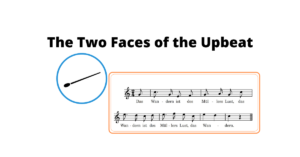Imagine you’re Beethoven. You must captivate your audience with your melodies. How do you do that? Fortunately, you have a toolbox full of compositional tricks at your disposal. One of them is syncopation.
What you will read in this article:
Write syncopations like Beethoven
Imagine you’re Beethoven. You are writing a new symphony (it is now the ninth – series have sold well even then). It should be big, with choir and orchestra, and of course successful, preferably a real crowd puller. The text you want to set to music is already on your desk:
Deine Zauber binden wieder,
Was die Mode streng geteilt,
Alle Menschen werden Brüder,
Wo dein sanfter Flügel weilt.
From: Friedrich Schiller, “An die Freude”. Translation:
Thy magic binds again
What custom strictly divided;
All people become brothers,
Where thy gentle wing abides.
https://en.wikipedia.org/wiki/Ode_to_Joy, 22/AUG/2020
So how do you write a melody that sweeps the audience off their feet? As a good composer (and if you are Beethoven, you are a good composer) you first do a thorough text analysis:
Deine Zauber binden wieder,
Was die Mode streng geteilt,
Alle Menschen werden Brüder,
Wo dein sanfter Flügel weilt.
It looks like heavy and light syllables alternate with each other – a so-called trochee. You’re lucky. Because that takes a compositional decision off your hands: the choice of time signature.
The world of music provides you with a time signature, the stress pattern of which corresponds exactly to a trochee. This is the 4/4 time signature (pronounced “four-four time”), which has the main emphasis on the first and third quarters (“on 1” and “on 3”) and the secondary emphasis on the second and fourth quarters (“on 2” and “on 4”).
Practical, isn’t it?

The 4/4 bar means that you must place notes (and/or rests) with a total duration of exactly four quarter notes between two bar lines. So you can fill the bar with four quarter notes, two half notes, eight quavers – or any combination of these. The main thing is that in the end you get a total of four quarters.

Syncopation – step by step
Perhaps you woke up in the morning with a melody in your head that fits well into this beat pattern. Perhaps a fragment of a melody comes to your mind spontaneously while reading the text that you have to set to music. Or perhaps you are simply copying from a composer colleague (this was more common in Beethoven’s day than you might think!) Either way – you are now beginning to compose:

Hmm… Not bad. But it’s not gonna really sweep the audience off their feet. So you try different solutions. Maybe a different rhythm would help?

Well… Not really. Also, the final syllables of the words are now very short, which could be bad for the comprehensibility of the text. You reject the changed rhythm and think about what you could do instead. Suddenly you get the brilliant idea: a syncopation!
Then you try desperately to remember your composition training and ask yourself: What was that again? (All right – that probably would not have happened to Beethoven 😊).
Syncopation – a definition

Adrian, the Music Theory MentOWL:
1 Elmar Bozetti: Einführung in musikalisches Verstehen und Gestalten. Frankfurt 1988, P. 143. Cited and translated from https://de.wikipedia.org/wiki/Synkope_(Musik), 22/AUG/2020
Thanks, Adrian!
You must therefore emphasize an actually unaccented beat of the 4/4 bar (i.e. a “2” or a “4”) unusually strongly if your melody is to become exciting. How do you do that? For example, by lengthening a note on an unstressed beat so that it reaches into the following stressed beat.

This is it! This is the power of syncopation! The use of a single compositional tool takes your melody to a higher level. Beethoven makes it sound like this:
This recording is from the European Archive and is part of the Public Domain. It is not subject to any known limitations on copyright and all related and neighbouring rights.
By the way: This is by far not the only way to write a syncopation. Adrian shows us another one:

Adrian, the Music Theory MentOWL:
1 Cited and translated from https://de.wikipedia.org/wiki/Synkope_(Musik), 22/AUG/2020
How that works? Read about it in my article about the first movement of Mozart’s “Prague” Symphony.

Jonathan Stark – Conductor
Hello! I'm Jonathan Stark. As a conductor, it is important to me that visits to concerts and operas leave a lasting impression on the audience. Background knowledge helps to achieve this. That's why I blog here about key works of classical music, about composers, about opera and much more that happens in the exciting world of music.








Hallo Herr Stark,
Nomen ist Omen, könnte man meinen. Das ist wirklich alles sehr stark erklärt, hier in diesem Blog. Es freut mich, dass ich da zufällig darüber gestolpert bin. Werde sicher viele ihrer Beiträge durchforsten und ihren Blog im Auge behalten.
Vielen Dank und Liebe Grüße
Jürgen Pathy aka Klassikpunk
Hallo Herr Pathy,
vielen Dank für das nette Kompliment, das freut mich sehr! Ich wünsche weiterhin viel Spaß beim Stöbern.
Herzliche Grüße,
Jonathan Stark